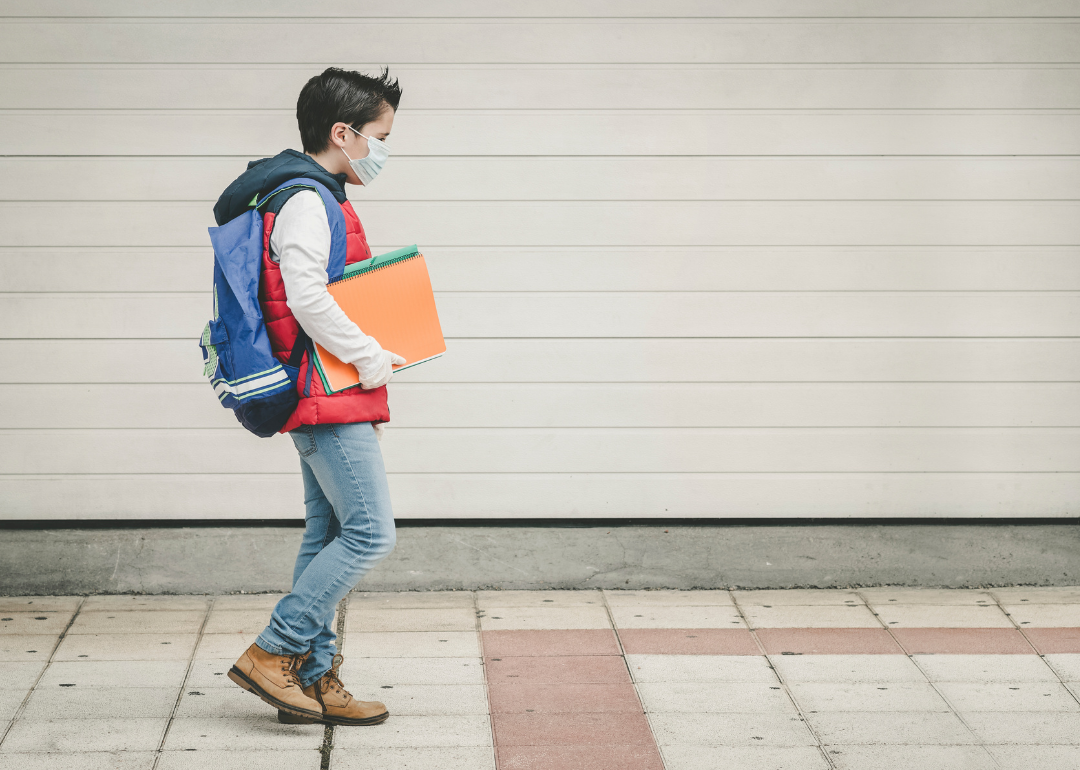
States where COVID-19 has widened student achievement gaps
States where COVID-19 has widened student achievement gaps
When schools across the country moved to distance learning in the spring to try to curb the spread of the coronavirus, educators and others immediately worried about students on the wrong side of the digital divide. Schools have already been confronting persistent achievement gaps between low- and high-income students, as well as between Black and Hispanic students and white students, and time away from school seemed likely to worsen it. McKinsey & Company published a report in June predicting that low-income, Black, and Hispanic students would probably experience the greatest losses in learning.
The Opportunity Insights Economic Tracker, a project by a team of researchers based at Harvard University, compiles and tracks the economic impacts of COVID-19 on businesses and communities across America. One area of research for the group is student activity on Zearn, a math application which is used for online instruction across the country. The OIET has compiled data on both student engagement and student achievement (measured in "badges" earned by students) for K-12 students, broken down by month and by economic status.
Stacker has identified the achievement and engagement changes driven by COVID-19 for students in every state, based on comparing average Zearn activity in January and February 2020 to average activity in March through June. Stacker compared the achievement and engagement for schools in high-income ZIP codes (defined by the tracker as the 25% of ZIP codes with the highest median income) to the achievement and engagement for schools in low-income ZIP codes (the 25% of ZIP codes with the lowest median income). States and Washington D.C. are ranked here according to their achievement gaps—the differences in achievement between these two groups. Eight states do not have data available for either the high- or low-income group and are therefore not ranked in the story.
Read on to learn about COVID-19's effects on learning in your state.

Arkansas (not ranked)
- Overall achievement change in online math program, winter to spring 2020: -34.3%
--- Achievement change for schools in high-income ZIP codes: not available
--- Achievement change for schools in low-income ZIP codes: -45.4%
- Overall engagement change in online math program, winter to spring 2020: -46.7%
--- Engagement change for schools in high-income ZIP codes: not available
--- Engagement change for schools in low-income ZIP codes: -54.3%
Arkansas is using $10 million in federal aid to buy 20,000 Wi-Fi devices so that students can access the internet at home. They will have two years of unlimited data. Over the summer, students were able to take advantage of virtual tutoring and even a virtual art camp. Still, education officials expect 70% of students to fall behind in learning.

Hawaii (not ranked)
- Overall achievement change in online math program, winter to spring 2020: -3.2%
--- Achievement change for schools in high-income ZIP codes: -1.0%
--- Achievement change for schools in low-income ZIP codes: not available
- Overall engagement change in online math program, winter to spring 2020: -34.0%
--- Engagement change for schools in high-income ZIP codes: -28.1%
--- Engagement change for schools in low-income ZIP codes: not available
Hawaii got $43 million in federal funding via the Elementary and Secondary School Emergency Relief Fund, part of the CARES Act. The money can be used for laptops, hotspot devices, and other technology, for mental health services for students, and to help teachers move to online learning.
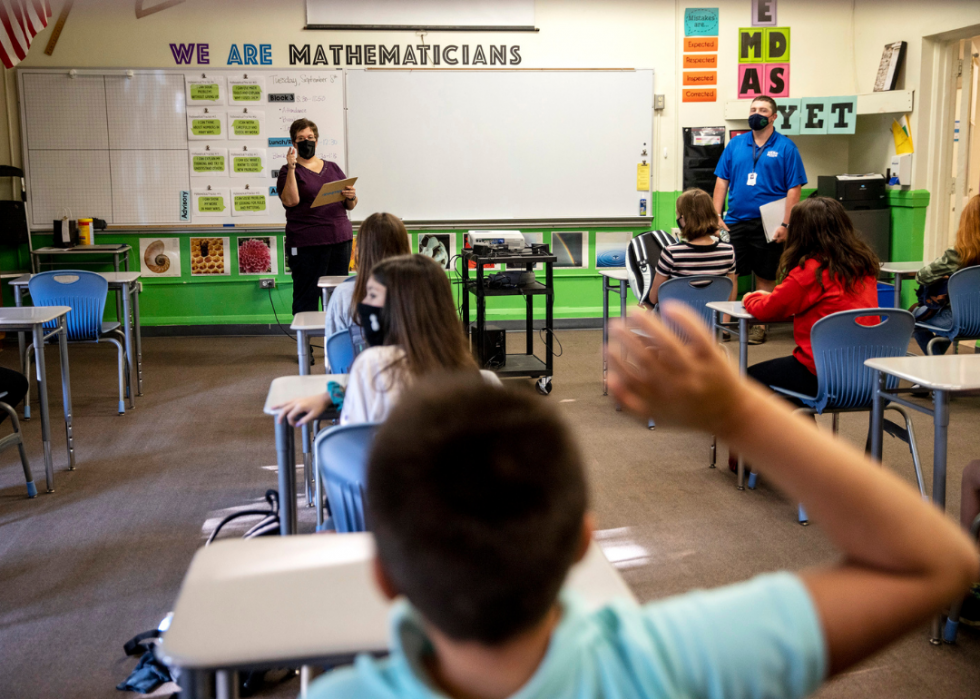
Maine (not ranked)
- Overall achievement change in online math program, winter to spring 2020: 38.5%
--- Achievement change for schools in high-income ZIP codes: not available
--- Achievement change for schools in low-income ZIP codes: 9.7%
- Overall engagement change in online math program, winter to spring 2020: -6.1%
--- Engagement change for schools in high-income ZIP codes: not available
--- Engagement change for schools in low-income ZIP codes: -20.4%
Maine is using $9 million of its federal relief to help 24,000 students connect to the internet with Wi-Fi hotspots and to buy laptops and tablets. Critics say more money should have gone to improving internet access in rural areas.
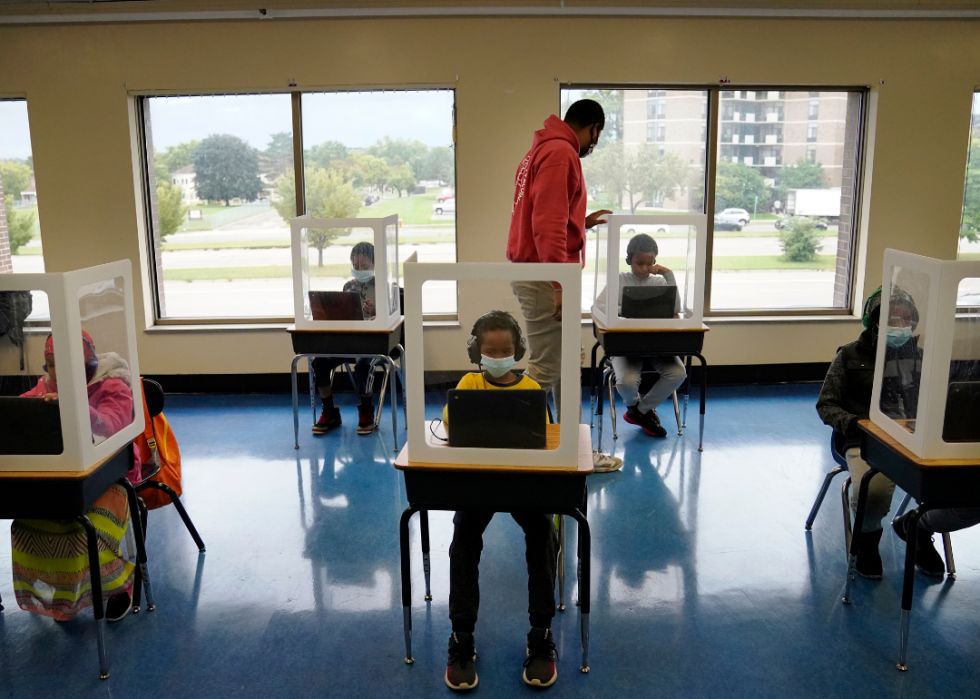
Minnesota (not ranked)
- Overall achievement change in online math program, winter to spring 2020: -11.9%
--- Achievement change for schools in high-income ZIP codes: -26.4%
--- Achievement change for schools in low-income ZIP codes: not available
- Overall engagement change in online math program, winter to spring 2020: -31.1%
--- Engagement change for schools in high-income ZIP codes: -39.3%
--- Engagement change for schools in low-income ZIP codes: not available
In Minneapolis, a so-called “pandemic pod” was created with a twist: for a poorer neighborhood to offer assistance to children in danger of falling behind, with tutors helping students engaged in distance learning. Corporations and community organizations are funding other pods emphasizing support for students of color with tutors, Chromebooks, internet access, and other services. Typically, the pods are created by relatively wealthy parents.
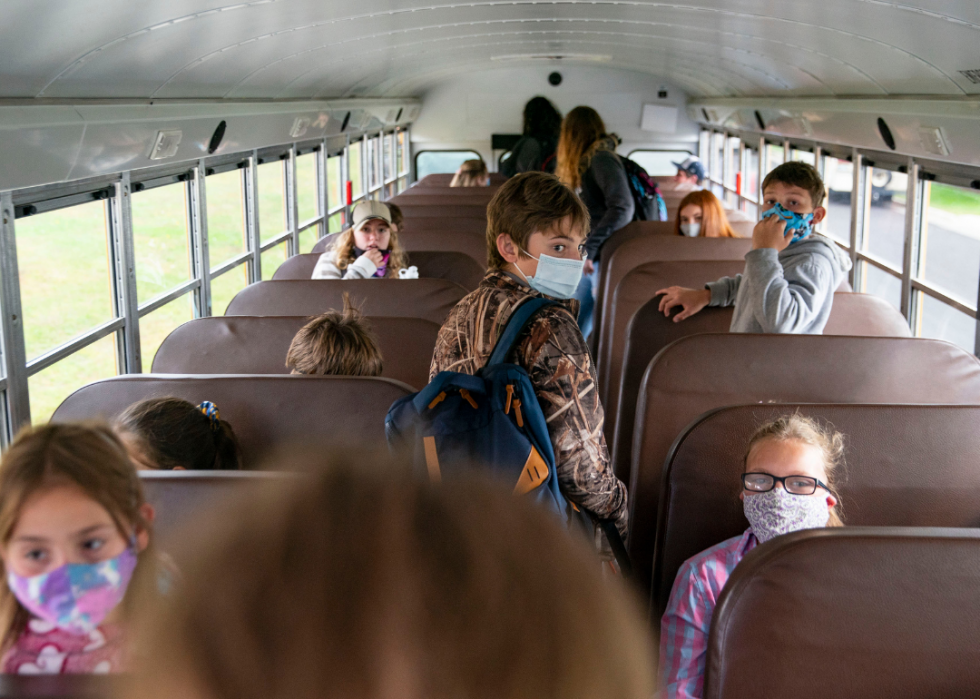
Montana (not ranked)
- Overall achievement change in online math program, winter to spring 2020: -2.6%
--- Achievement change for schools in high-income ZIP codes: not available
--- Achievement change for schools in low-income ZIP codes: -26.6%
- Overall engagement change in online math program, winter to spring 2020: -24.7%
--- Engagement change for schools in high-income ZIP codes: not available
--- Engagement change for schools in low-income ZIP codes: -44.1%
Montana schools got $41 million directly from the CARES Act and another $75 million to help schools reopen. The state is providing special education services to students with disabilities while schools are closed. One school district used stimulus money to hire roving substitute teachers, who are in short supply during the pandemic.

Nebraska (not ranked)
- Overall achievement change in online math program, winter to spring 2020: -22.0%
--- Achievement change for schools in high-income ZIP codes: not available
--- Achievement change for schools in low-income ZIP codes: -15.2%
- Overall engagement change in online math program, winter to spring 2020: -38.9%
--- Engagement change for schools in high-income ZIP codes: not available
--- Engagement change for schools in low-income ZIP codes: -28.5%
Nebraska schools were allocated $60.8 million from the federal Elementary and Secondary School Emergency Relief Fund in the CARES Act. The state’s application for money from the federal Governor's Emergency Education Relief claims it will focus on providing internet access for students, including installing community Wi-Fi hotspots in underserved communities.

North Dakota (not ranked)
- Overall achievement change in online math program, winter to spring 2020: 18.3%
--- Achievement change for schools in high-income ZIP codes: 47.1%
--- Achievement change for schools in low-income ZIP codes: not available
- Overall engagement change in online math program, winter to spring 2020: 1.6%
--- Engagement change for schools in high-income ZIP codes: 8.5%
--- Engagement change for schools in low-income ZIP codes: not available
North Dakota is using its $31 million for schools from the CARES Act mainly to allow schools to pay for extra staff and to fund a software program that provides individual assistance in math, reading, and English. Some of the money will be allocated to help families acquire broadband service for distance learning.

Vermont (not ranked)
- Overall achievement change in online math program, winter to spring 2020: 91.2%
--- Achievement change for schools in high-income ZIP codes: not available
--- Achievement change for schools in low-income ZIP codes: 87.5%
- Overall engagement change in online math program, winter to spring 2020: 18.1%
--- Engagement change for schools in high-income ZIP codes: not available
--- Engagement change for schools in low-income ZIP codes: 3.9%
All public high schools in Vermont must offer personalized learning, from internships to online classes. Coordinators keep the program going, according to the education publication The 74 Million, and they are now using these personalized learning programs to create the remote and combination instruction necessitated by the pandemic.

West Virginia (not ranked)
- Overall achievement change in online math program, winter to spring 2020: -6.8%
--- Achievement change for schools in high-income ZIP codes: not available
--- Achievement change for schools in low-income ZIP codes: -9.7%
- Overall engagement change in online math program, winter to spring 2020: -33.6%
--- Engagement change for schools in high-income ZIP codes: not available
--- Engagement change for schools in low-income ZIP codes: -33.9%
West Virginia created a committee to find ways for teachers to identify student weaknesses and gaps in learning that may be related to the COVID-19 pandemic. It received $86.6 million from the CARES Act’s Elementary and Secondary School Emergency Relief Fund. Money was allocated for buying technology and closing achievement gaps.
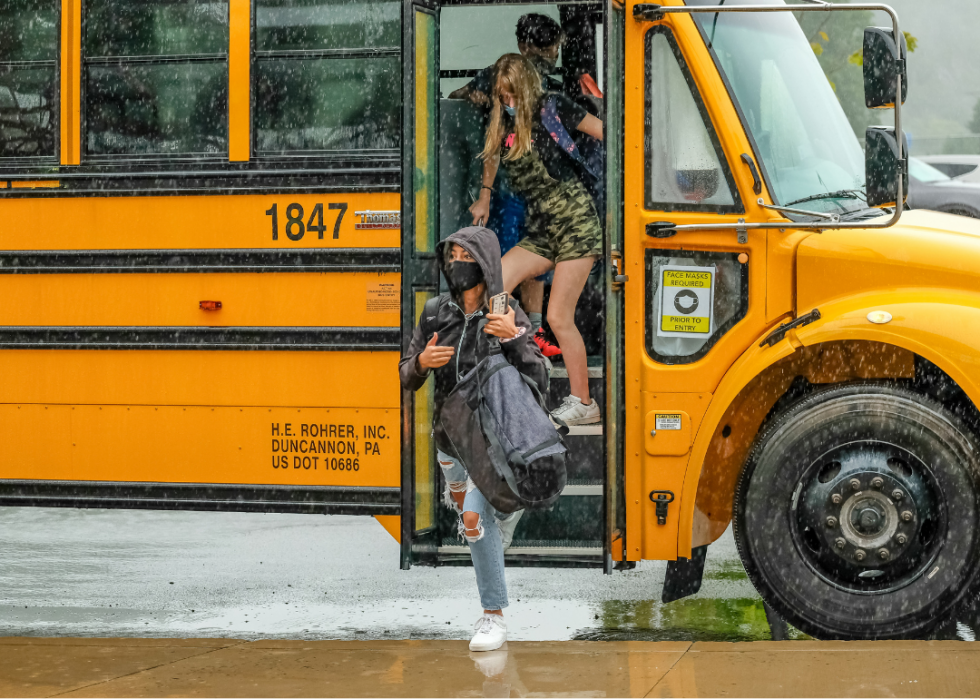
#42. Delaware
- Overall achievement change in online math program, winter to spring 2020: 25.6%
--- Achievement change for schools in high-income ZIP codes: -44.4%
--- Achievement change for schools in low-income ZIP codes: 27.1%
--- Achievement gap: -71.5%
- Overall engagement change in online math program, winter to spring 2020: -10.2%
--- Engagement change for schools in high-income ZIP codes: -42.8%
--- Engagement change for schools in low-income ZIP codes: -31.6%
--- Engagement gap: -11.2% (#36 highest among all states)
Delaware will receive nearly $50 million for its public schools through the federal CARES Act. It also settled an education equity lawsuit brought by Delawareans for Educational Opportunity and the NAACP of Delaware that highlighted a lack of resources for low-income students. It adds resources for English learners and low-income students, an amount now at $25 million and which will rise to $60 million by the 2024-2025 school year.

#41. Oklahoma
- Overall achievement change in online math program, winter to spring 2020: -25.5%
--- Achievement change for schools in high-income ZIP codes: -82.0%
--- Achievement change for schools in low-income ZIP codes: -20.2%
--- Achievement gap: -61.8%
- Overall engagement change in online math program, winter to spring 2020: -44.4%
--- Engagement change for schools in high-income ZIP codes: -82.4%
--- Engagement change for schools in low-income ZIP codes: -43.0%
--- Engagement gap: -39.4% (#40 highest among all states)
Governor Kevin Stitt announced in July that $10 million of the state’s discretionary federal COVID-19 aid would be spent on stipends for students attending private schools. The money goes to low-income families, according to officials, but advocates criticized the governor, claiming the state had not met the needs of public school students, including access to the internet.
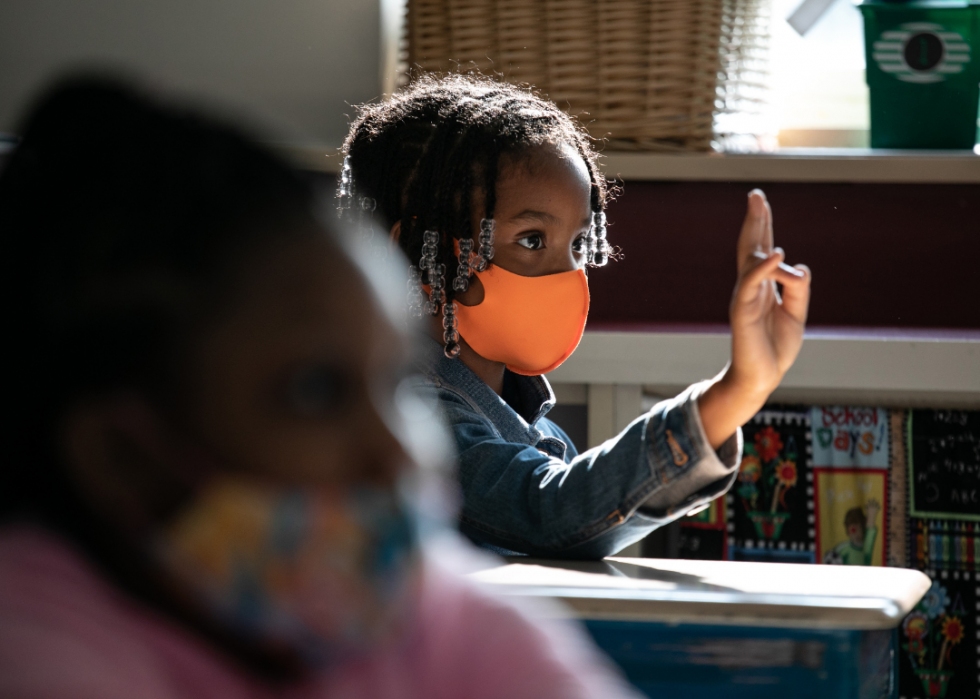
#40. Connecticut
- Overall achievement change in online math program, winter to spring 2020: 69.3%
--- Achievement change for schools in high-income ZIP codes: 62.7%
--- Achievement change for schools in low-income ZIP codes: 117.4%
--- Achievement gap: -54.7%
- Overall engagement change in online math program, winter to spring 2020: 22.7%
--- Engagement change for schools in high-income ZIP codes: 15.6%
--- Engagement change for schools in low-income ZIP codes: 58.4%
--- Engagement gap: -42.7% (#41 highest among all states)
A survey conducted by Connecticut’s largest teachers union found that more than a third said their students did not have access to the internet. More than a quarter said their students did not have computers and other devices, while more than half said they lacked what they needed for distance learning.
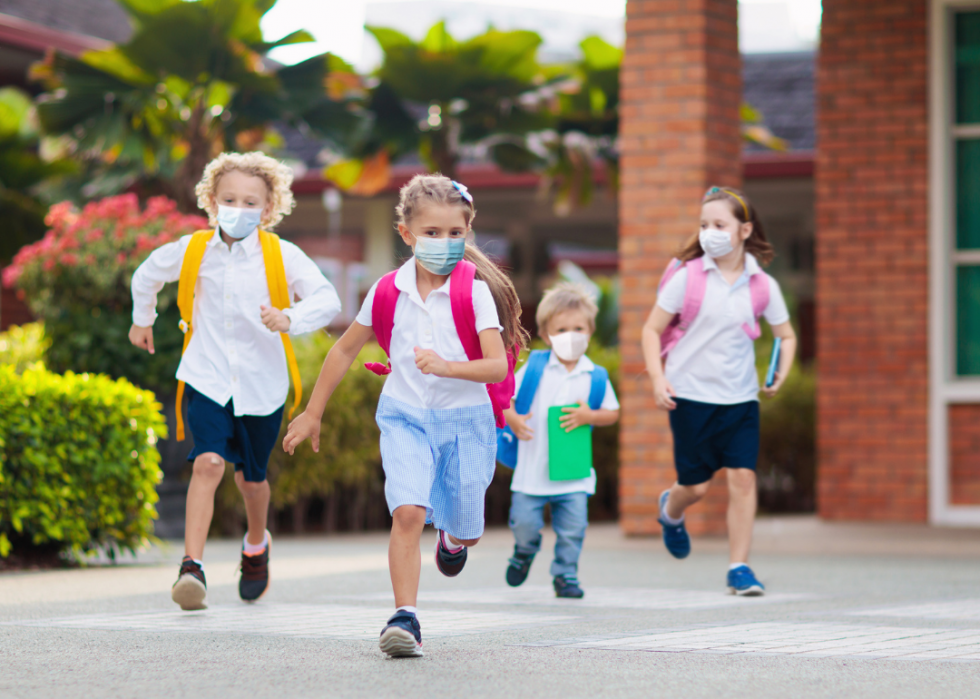
#39. Idaho
- Overall achievement change in online math program, winter to spring 2020: -16.8%
--- Achievement change for schools in high-income ZIP codes: -25.2%
--- Achievement change for schools in low-income ZIP codes: 16.3%
--- Achievement gap: -41.5%
- Overall engagement change in online math program, winter to spring 2020: -33.6%
--- Engagement change for schools in high-income ZIP codes: -41.5%
--- Engagement change for schools in low-income ZIP codes: -17.3%
--- Engagement gap: -24.1% (#38 highest among all states)
Gov. Brad Little pressed schools to reopen for in-person learning, arguing that the learning gap would otherwise widen. The state allocated $48 million to improve access to the internet and equip schools with computers and other devices.

#38. Wyoming
- Overall achievement change in online math program, winter to spring 2020: 24.1%
--- Achievement change for schools in high-income ZIP codes: -19.9%
--- Achievement change for schools in low-income ZIP codes: 17.3%
--- Achievement gap: -37.2%
- Overall engagement change in online math program, winter to spring 2020: -14.9%
--- Engagement change for schools in high-income ZIP codes: -48.8%
--- Engagement change for schools in low-income ZIP codes: 10.9%
--- Engagement gap: -59.7% (#42 highest among all states)
Wyoming was awarded a grant of $8.7 million to hire a full-time literacy director and take other steps for children failing to read at grade level. It is focusing on achievement gaps among Native American students, Black students, children for whom English is a second language, and children with disabilities.

#37. Texas
- Overall achievement change in online math program, winter to spring 2020: -8.9%
--- Achievement change for schools in high-income ZIP codes: -42.2%
--- Achievement change for schools in low-income ZIP codes: -8.1%
--- Achievement gap: -34.1%
- Overall engagement change in online math program, winter to spring 2020: -32.3%
--- Engagement change for schools in high-income ZIP codes: -55.5%
--- Engagement change for schools in low-income ZIP codes: -23.2%
--- Engagement gap: -32.2% (#39 highest among all states)
Texas is using federal funds to improve distance learning and remote learning in school settings for disadvantaged students. School districts in the state were to receive $1.29 billion from the Elementary and Secondary School Emergency Relief Fund, the second-largest amount after California. However, districts were complaining that Texas was planning to cut its state aid at the same time.
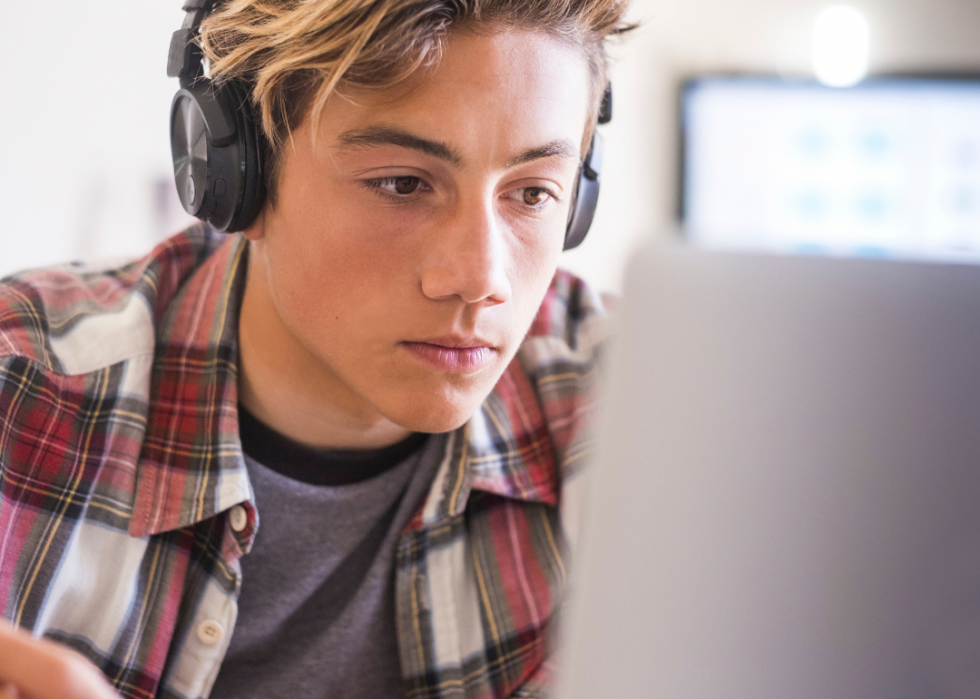
#36. South Carolina
- Overall achievement change in online math program, winter to spring 2020: -24.7%
--- Achievement change for schools in high-income ZIP codes: -49.0%
--- Achievement change for schools in low-income ZIP codes: -17.3%
--- Achievement gap: -31.7%
- Overall engagement change in online math program, winter to spring 2020: -42.7%
--- Engagement change for schools in high-income ZIP codes: -52.0%
--- Engagement change for schools in low-income ZIP codes: -48.1%
--- Engagement gap: -3.9% (#33 highest among all states)
Many rural students do not have access to Wi-Fi or high-speed Internet, and in July, schools could not reach 16,000 students. Districts are providing students with devices and hotspots. The state’s schools are receiving approximately $216 million from the CARES Act.
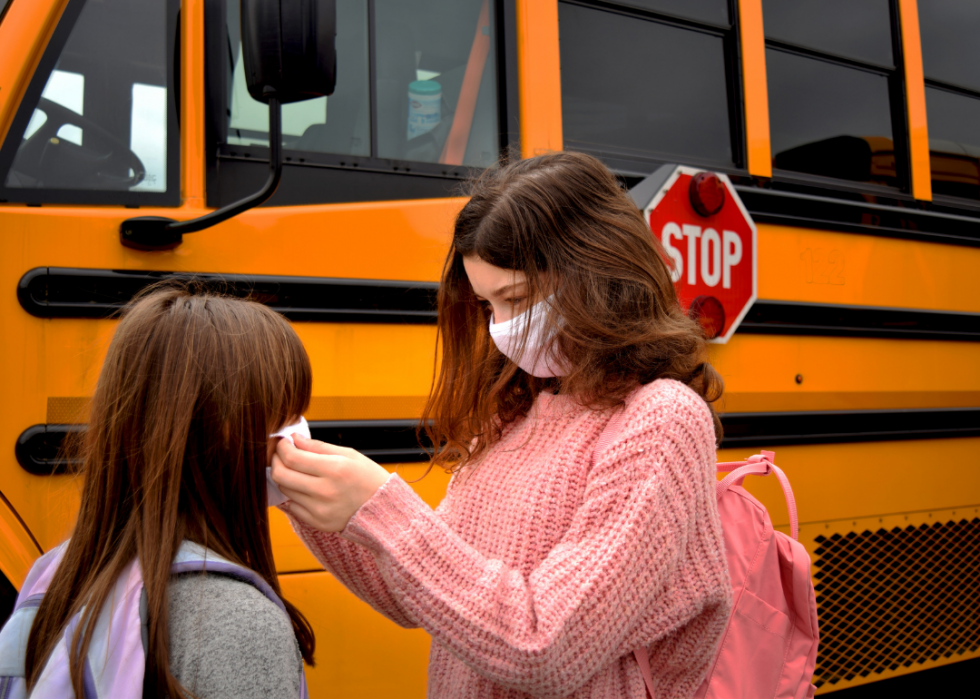
#35. Indiana
- Overall achievement change in online math program, winter to spring 2020: -39.6%
--- Achievement change for schools in high-income ZIP codes: -61.1%
--- Achievement change for schools in low-income ZIP codes: -31.6%
--- Achievement gap: -29.5%
- Overall engagement change in online math program, winter to spring 2020: -47.5%
--- Engagement change for schools in high-income ZIP codes: -60.8%
--- Engagement change for schools in low-income ZIP codes: -45.3%
--- Engagement gap: -15.5% (#37 highest among all states)
A report released in 2020 criticized Indiana for cutting funding for students from low-income families by about 35%. The Center on Reinventing Public Education found that schools with a larger proportion of students of color got about $1,600 less for each student and urged the state to change how it funded schools.

#34. Maryland
- Overall achievement change in online math program, winter to spring 2020: 3.6%
--- Achievement change for schools in high-income ZIP codes: -8.0%
--- Achievement change for schools in low-income ZIP codes: 5.0%
--- Achievement gap: -13.0%
- Overall engagement change in online math program, winter to spring 2020: -29.1%
--- Engagement change for schools in high-income ZIP codes: -34.9%
--- Engagement change for schools in low-income ZIP codes: -28.0%
--- Engagement gap: -6.9% (#35 highest among all states)
Maryland schools will get $210 million to improve remote learning, tutoring, and rural internet access as educators and students, but teachers and others say the money should have come earlier for students trying to keep up in the spring. Meanwhile, Gov. Larry Hogan proposed $300 million in budget cuts to schools. In Baltimore, the district is planning to play for internet service for families, bought 35,000 new computers, and got hot spots from T-Mobile.

#33. Iowa
- Overall achievement change in online math program, winter to spring 2020: -29.8%
--- Achievement change for schools in high-income ZIP codes: -21.6%
--- Achievement change for schools in low-income ZIP codes: -11.7%
--- Achievement gap: -9.9%
- Overall engagement change in online math program, winter to spring 2020: -45.8%
--- Engagement change for schools in high-income ZIP codes: -44.0%
--- Engagement change for schools in low-income ZIP codes: -40.1%
--- Engagement gap: -3.9% (#34 highest among all states)
A school survey in Des Moines found that most students had computer technology at home. However, the families of Black male students were more likely not to have devices, and nearly 9% of families did not have reliable internet access. The state received $71.6 million in federal relief funds for schools through the CARES Act.
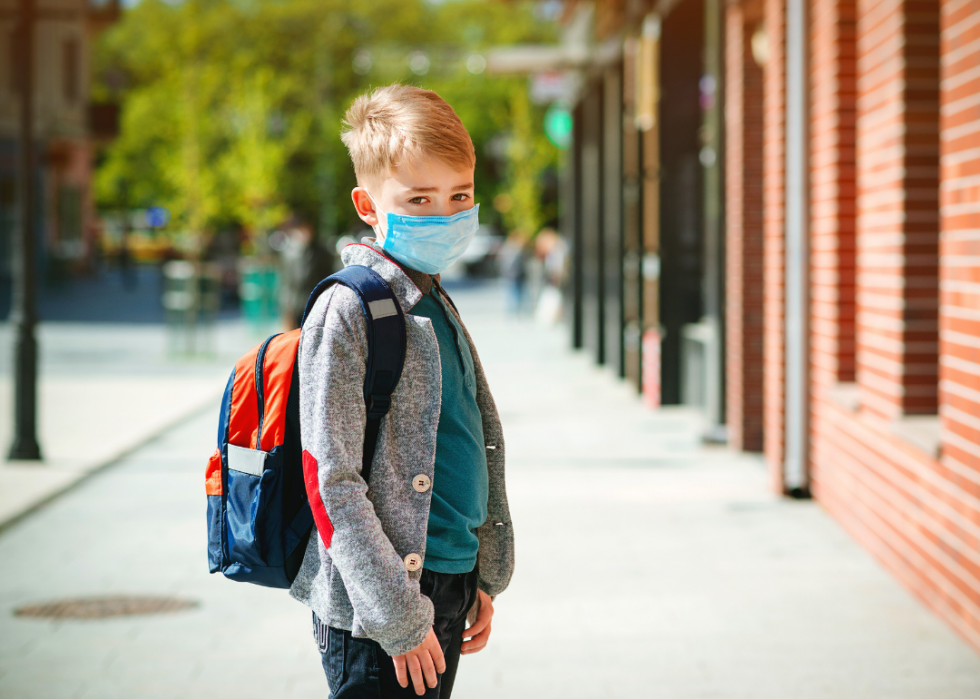
#32. Pennsylvania
- Overall achievement change in online math program, winter to spring 2020: 1.4%
--- Achievement change for schools in high-income ZIP codes: 5.1%
--- Achievement change for schools in low-income ZIP codes: 11.0%
--- Achievement gap: -5.9%
- Overall engagement change in online math program, winter to spring 2020: -21.1%
--- Engagement change for schools in high-income ZIP codes: -4.0%
--- Engagement change for schools in low-income ZIP codes: -25.4%
--- Engagement gap: 21.4% (#25 highest among all states)
Philadelphia's school district estimates that up to 5% of its students do not have reliable access to the internet. Since March, it has spent $11 million on 40,000 Chromebooks and bought 2,500 hotspots at $190 per person. Only 45% of students in grades 3-5 had access to the internet from a computer at home, according to a 2019 survey, while 56% of students in grades 6-8 and 58% of students in grades 9-12 had access. The city's main internet provider, Comcast, offered two free months to new customers and opened its public hotspots.
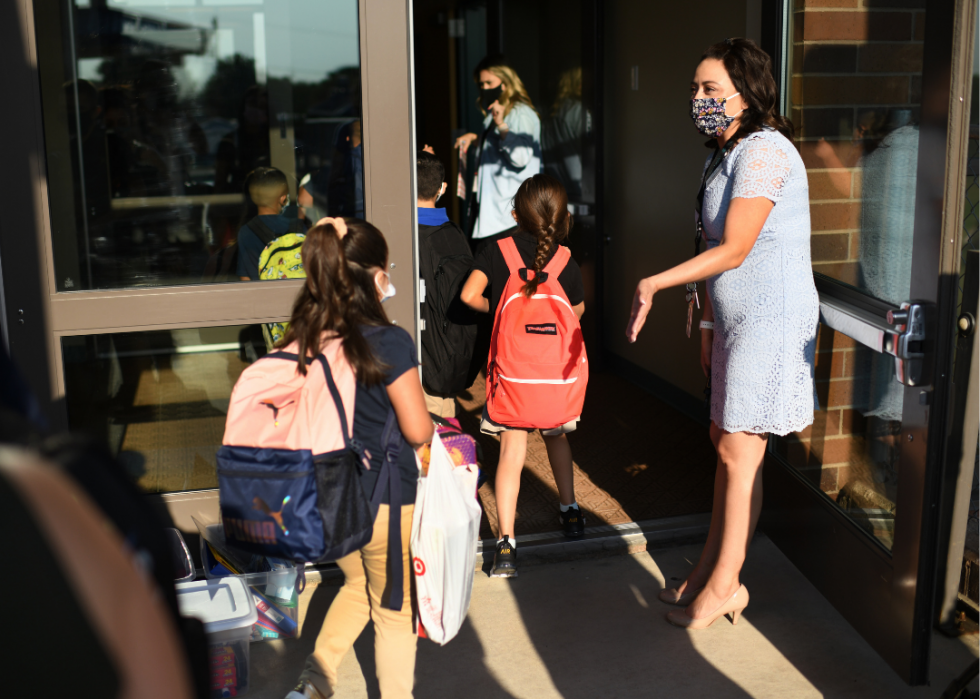
#31. Colorado
- Overall achievement change in online math program, winter to spring 2020: 27.5%
--- Achievement change for schools in high-income ZIP codes: 24.5%
--- Achievement change for schools in low-income ZIP codes: 17.1%
--- Achievement gap: 7.4%
- Overall engagement change in online math program, winter to spring 2020: -3.5%
--- Engagement change for schools in high-income ZIP codes: 2.6%
--- Engagement change for schools in low-income ZIP codes: -9.5%
--- Engagement gap: 12.1% (#31 highest among all states)
Colorado’s governor created a $32 million fund to help schools and universities called Response, Innovation & Student Equity, or RISE. The money is from the Governor’s Emergency Education Relief Fund, included in the CARES Act. The intent is to help rural communities, schools or districts with turnaround plans, or ones with academic gaps between students based on income, race, and other criteria.

#30. Virginia
- Overall achievement change in online math program, winter to spring 2020: -47.9%
--- Achievement change for schools in high-income ZIP codes: -45.9%
--- Achievement change for schools in low-income ZIP codes: -56.6%
--- Achievement gap: 10.8%
- Overall engagement change in online math program, winter to spring 2020: -53.9%
--- Engagement change for schools in high-income ZIP codes: -48.2%
--- Engagement change for schools in low-income ZIP codes: -51.3%
--- Engagement gap: 3.1% (#32 highest among all states)
In October, Gov. Ralph Northam allocated more than $220 million from the CARES Act to help public schools buy technology for distance learning and take other steps to educate students during the coronavirus pandemic. Schools also received nearly $67 million from the Governor’s Emergency Education Relief Fund of the CARES Act that can be used to help improve online learning for students.

#29. Tennessee
- Overall achievement change in online math program, winter to spring 2020: -41.3%
--- Achievement change for schools in high-income ZIP codes: -22.9%
--- Achievement change for schools in low-income ZIP codes: -38.2%
--- Achievement gap: 15.3%
- Overall engagement change in online math program, winter to spring 2020: -54.9%
--- Engagement change for schools in high-income ZIP codes: -41.8%
--- Engagement change for schools in low-income ZIP codes: -55.2%
--- Engagement gap: 13.4% (#30 highest among all states)
Tennessee’s education commissioner projected in September that students were showing a 50% drop in proficiency in third-grade reading and a 65% drop in proficiency in third-grade math. The commissioner, who like Gov. Bill Lee is pushing for the option of in-person classes, said it would mostly be up to the teachers to help students make up the loss. Among the federal COVID-19 relief funds that the state received through the CARES Act was $50 million for district technology grants for distance learning.
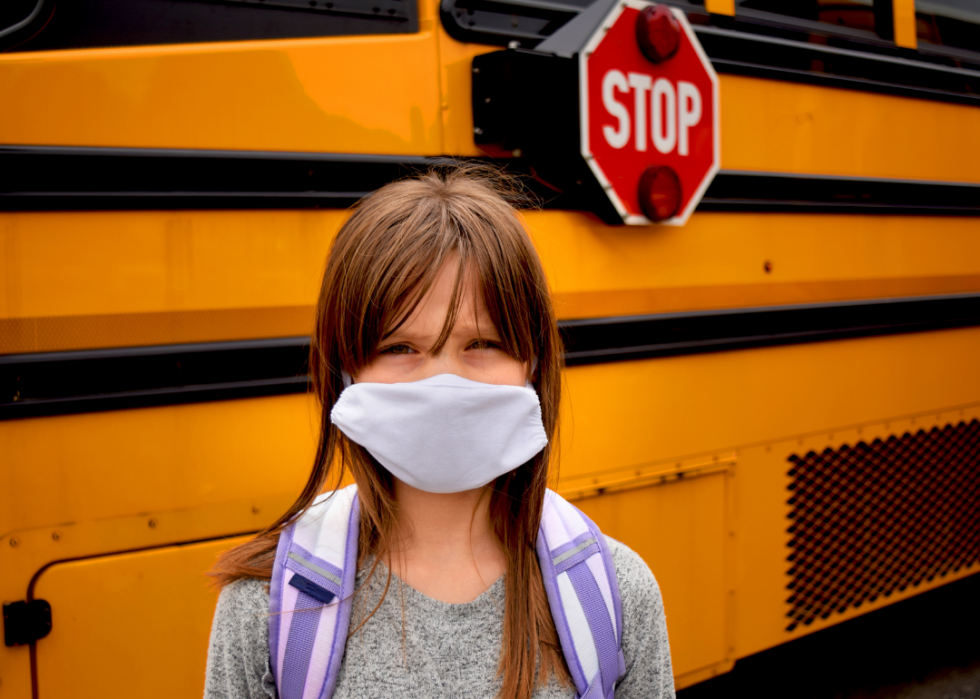
#28. Kansas
- Overall achievement change in online math program, winter to spring 2020: -21.5%
--- Achievement change for schools in high-income ZIP codes: -14.0%
--- Achievement change for schools in low-income ZIP codes: -36.6%
--- Achievement gap: 22.7%
- Overall engagement change in online math program, winter to spring 2020: -38.4%
--- Engagement change for schools in high-income ZIP codes: -34.6%
--- Engagement change for schools in low-income ZIP codes: -48.5%
--- Engagement gap: 13.9% (#29 highest among all states)
Nonprofit organization SchoolSmartKC donated more than $1.5 million to Kansas City Public Schools, charter schools, and other organizations to buy more than 2,500 laptops or tablets and more than 4,300 Wi-Fi hotspots. Nearly half of the district’s students are expected to face eviction this year and have to transfer to another school.

#27. California
- Overall achievement change in online math program, winter to spring 2020: 22.3%
--- Achievement change for schools in high-income ZIP codes: 37.7%
--- Achievement change for schools in low-income ZIP codes: 13.8%
--- Achievement gap: 23.9%
- Overall engagement change in online math program, winter to spring 2020: -9.4%
--- Engagement change for schools in high-income ZIP codes: 2.0%
--- Engagement change for schools in low-income ZIP codes: -18.6%
--- Engagement gap: 20.5% (#26 highest among all states)
A study from the University of Southern California in April 2020 found that about 250,000 families were affected by a learning gap in Los Angeles County. Less than half of the families in South and East Los Angeles have the technology they need for distance learning, and minority students are more likely to live in communities with less sophisticated technology. Some city schools are warning Gov. Gavin Newsom that his budget cuts will prevent them from helping students catch up and keep them safe.
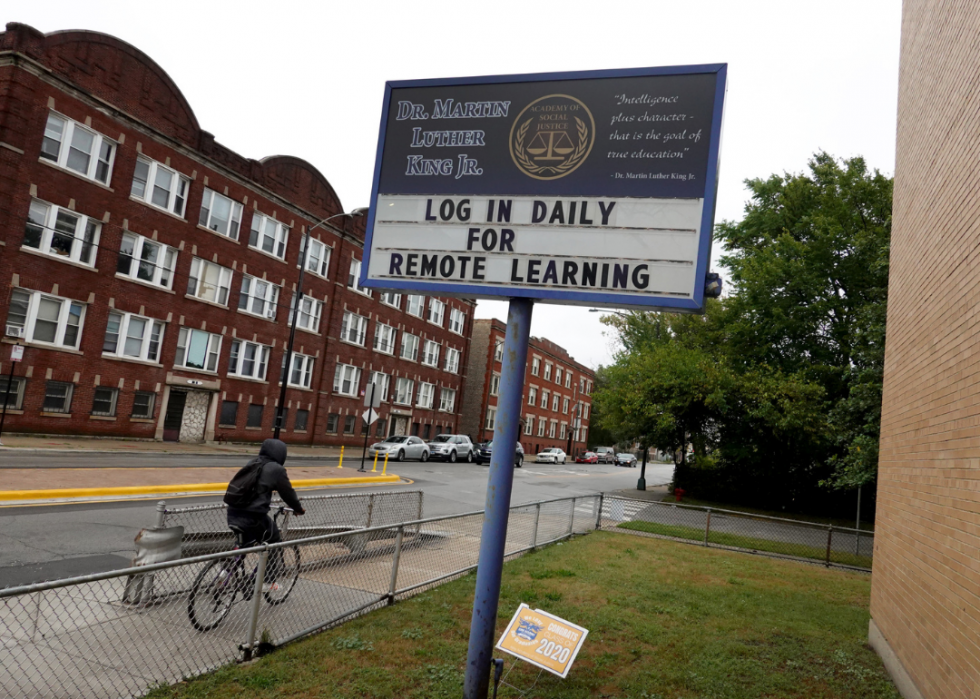
#26. Illinois
- Overall achievement change in online math program, winter to spring 2020: 4.7%
--- Achievement change for schools in high-income ZIP codes: 19.8%
--- Achievement change for schools in low-income ZIP codes: -4.8%
--- Achievement gap: 24.6%
- Overall engagement change in online math program, winter to spring 2020: -15.9%
--- Engagement change for schools in high-income ZIP codes: -1.0%
--- Engagement change for schools in low-income ZIP codes: -30.6%
--- Engagement gap: 29.6% (#19 highest among all states)
An analysis from the Chicago Tribune and ProPublica Illinois revealed unequal access to internet connectivity, cellphones, computers, or cellphone data plans across the state. Chicago Public Schools was unable to make contact with 559 students in the spring and was missing information on another 405.

#25. Rhode Island
- Overall achievement change in online math program, winter to spring 2020: 39.1%
--- Achievement change for schools in high-income ZIP codes: 51.2%
--- Achievement change for schools in low-income ZIP codes: 23.8%
--- Achievement gap: 27.4%
- Overall engagement change in online math program, winter to spring 2020: 8.5%
--- Engagement change for schools in high-income ZIP codes: 25.0%
--- Engagement change for schools in low-income ZIP codes: -5.0%
--- Engagement gap: 30.0% (#18 highest among all states)
Rhode Island got a $10.9 million grant to find better ways to meet its students’ needs during the COVID-19 pandemic, one of only 11 states to receive an award. It will expand the number of free courses allowing students to earn college credits, place more counselors in schools in high-poverty areas, and make other changes.
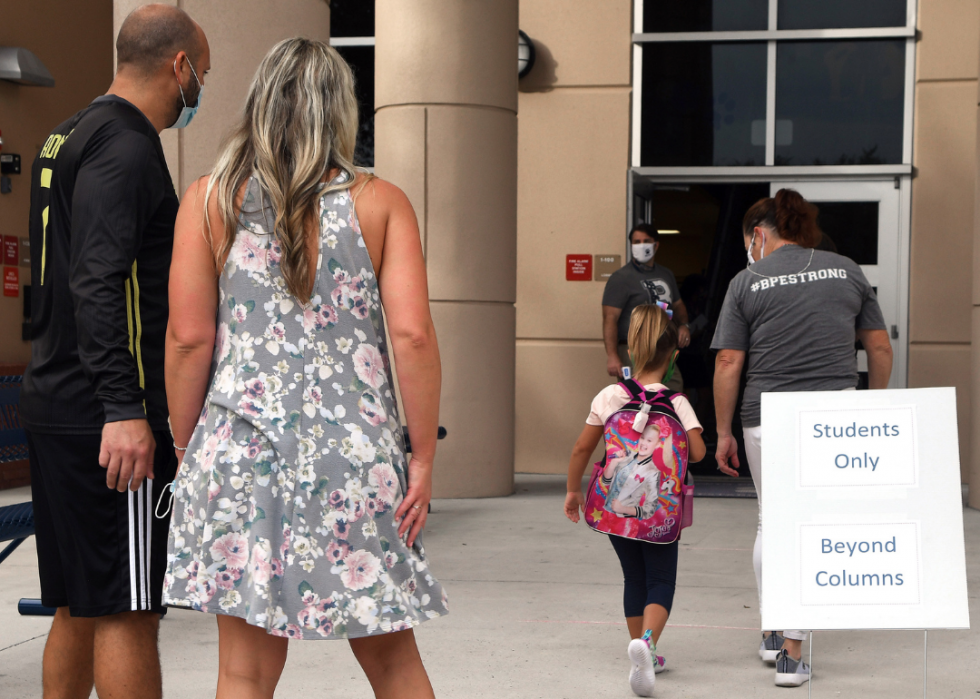
#24. Florida
- Overall achievement change in online math program, winter to spring 2020: 0.9%
--- Achievement change for schools in high-income ZIP codes: 12.5%
--- Achievement change for schools in low-income ZIP codes: -20.8%
--- Achievement gap: 33.2%
- Overall engagement change in online math program, winter to spring 2020: -24.1%
--- Engagement change for schools in high-income ZIP codes: -12.7%
--- Engagement change for schools in low-income ZIP codes: -34.3%
--- Engagement gap: 21.6% (#24 highest among all states)
Governor Ron DeSantis has pushed Florida’s schools to reopen. To assist the schools, the state allocated $64 million to close achievement gaps, which included adding a reading program over the summer for elementary students, $20 million to pinpoint additional reading for younger students, and $15 million to train reading coaches. Breakthrough Miami, part of a San Francisco-based nonprofit, provided remote learning by teachers in training to 800 students in Miami.

#23. Michigan
- Overall achievement change in online math program, winter to spring 2020: -12.6%
--- Achievement change for schools in high-income ZIP codes: 16.6%
--- Achievement change for schools in low-income ZIP codes: -18.1%
--- Achievement gap: 34.7%
- Overall engagement change in online math program, winter to spring 2020: -33.0%
--- Engagement change for schools in high-income ZIP codes: -14.0%
--- Engagement change for schools in low-income ZIP codes: -38.5%
--- Engagement gap: 24.5% (#23 highest among all states)
A nonprofit called Education Trust-Midwest released what it is calling “Marshall Plan: Reimagining Michigan Public Education.” It calls for summer school, tutoring, and other ways to extend learning time, improve access to virtual learning, and adopt other changes. The state anticipates a $1.2 billion shortfall in school aid funding for the 2019-20 school year.
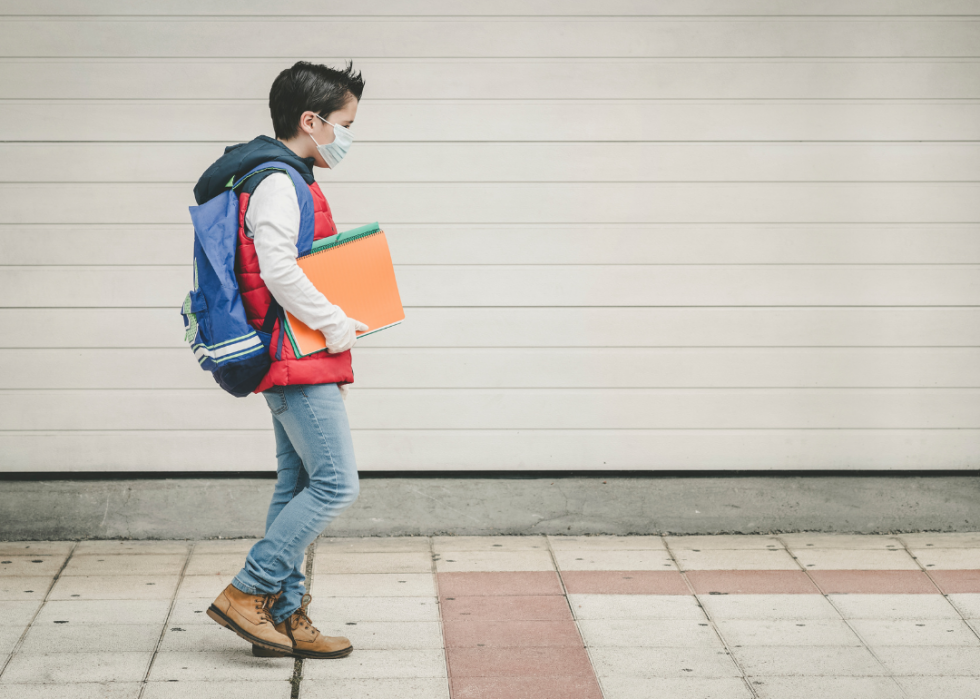
#22. South Dakota
- Overall achievement change in online math program, winter to spring 2020: -1.4%
--- Achievement change for schools in high-income ZIP codes: 11.0%
--- Achievement change for schools in low-income ZIP codes: -24.6%
--- Achievement gap: 35.6%
- Overall engagement change in online math program, winter to spring 2020: -16.2%
--- Engagement change for schools in high-income ZIP codes: -1.2%
--- Engagement change for schools in low-income ZIP codes: -45.4%
--- Engagement gap: 44.1% (#4 highest among all states)
Native Americans in the state have been disproportionately affected by the coronavirus, which led to the formation of a new homeschooling group, Lakota Oyate Homeschool Co-op. Its 60 parents will volunteer their expertise in classes on Lakota culture, language, tribal law, and other topics. Meanwhile, Teach for America retrained 17 teachers headed for reservation schools.

#21. North Carolina
- Overall achievement change in online math program, winter to spring 2020: -11.0%
--- Achievement change for schools in high-income ZIP codes: 17.5%
--- Achievement change for schools in low-income ZIP codes: -18.3%
--- Achievement gap: 35.8%
- Overall engagement change in online math program, winter to spring 2020: -32.5%
--- Engagement change for schools in high-income ZIP codes: -10.0%
--- Engagement change for schools in low-income ZIP codes: -39.2%
--- Engagement gap: 29.3% (#20 highest among all states)
Across North Carolina, 24% of households lack high-speed internet access sufficient for video streaming. In Wake County, the state’s largest district, 13% do not have high-speed access, and 3% do not even have a computer. The state is spending $95.6 million in federal funding to help elementary, secondary, and university students most affected by the pandemic. That includes $20 million for after-school programming and tutoring for at-risk students and students with disabilities.
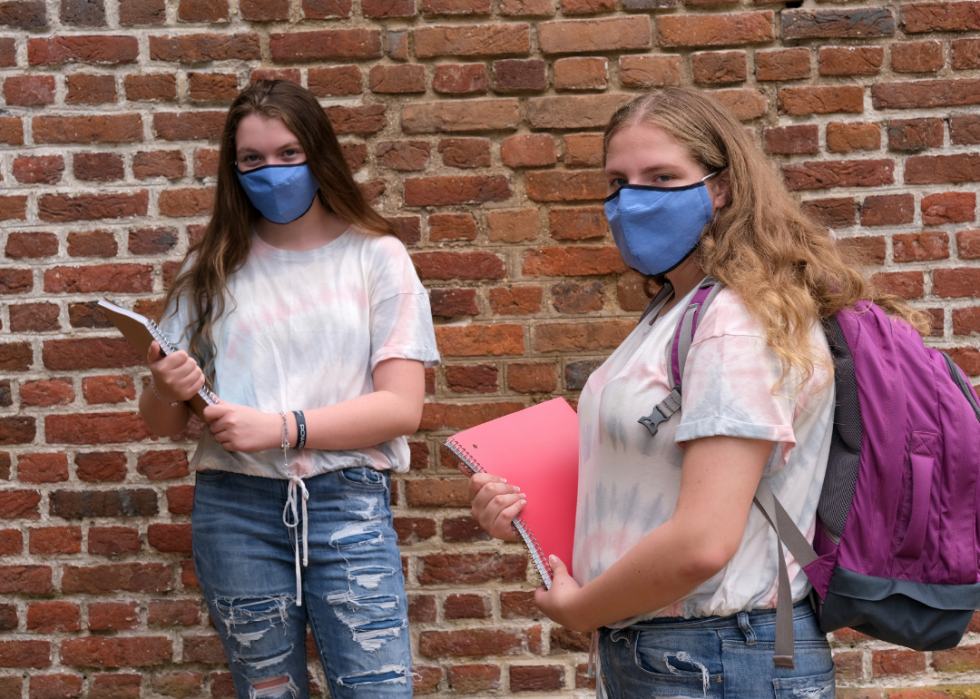
#20. Louisiana
- Overall achievement change in online math program, winter to spring 2020: -39.0%
--- Achievement change for schools in high-income ZIP codes: -8.3%
--- Achievement change for schools in low-income ZIP codes: -44.2%
--- Achievement gap: 35.9%
- Overall engagement change in online math program, winter to spring 2020: -44.1%
--- Engagement change for schools in high-income ZIP codes: -29.5%
--- Engagement change for schools in low-income ZIP codes: -48.0%
--- Engagement gap: 18.5% (#27 highest among all states)
Jefferson Parish Schools are being held up by The 74 Million as an example of a district that kept students learning across incomes. It created a call center where educators answered questions about lessons and technology each day, distributed email addresses with students’ lunches, trained teachers in Google Classroom, and teamed with an internet company to provide low-cost internet service for families.

#19. Ohio
- Overall achievement change in online math program, winter to spring 2020: -4.7%
--- Achievement change for schools in high-income ZIP codes: 15.0%
--- Achievement change for schools in low-income ZIP codes: -23.6%
--- Achievement gap: 38.6%
- Overall engagement change in online math program, winter to spring 2020: -25.4%
--- Engagement change for schools in high-income ZIP codes: -2.5%
--- Engagement change for schools in low-income ZIP codes: -38.5%
--- Engagement gap: 36.0% (#12 highest among all states)
Ohio released $100 million in federal funds as schools got ready to open, some of which will be used for remote learning. It had been a roller-coaster period for the schools: first $355 million was cut because of budget shortfalls, then $489 million was added through the CARES act. In the latter case, some poor districts like Dayton benefited by millions, but later the state restored $23 million to wealthier districts.
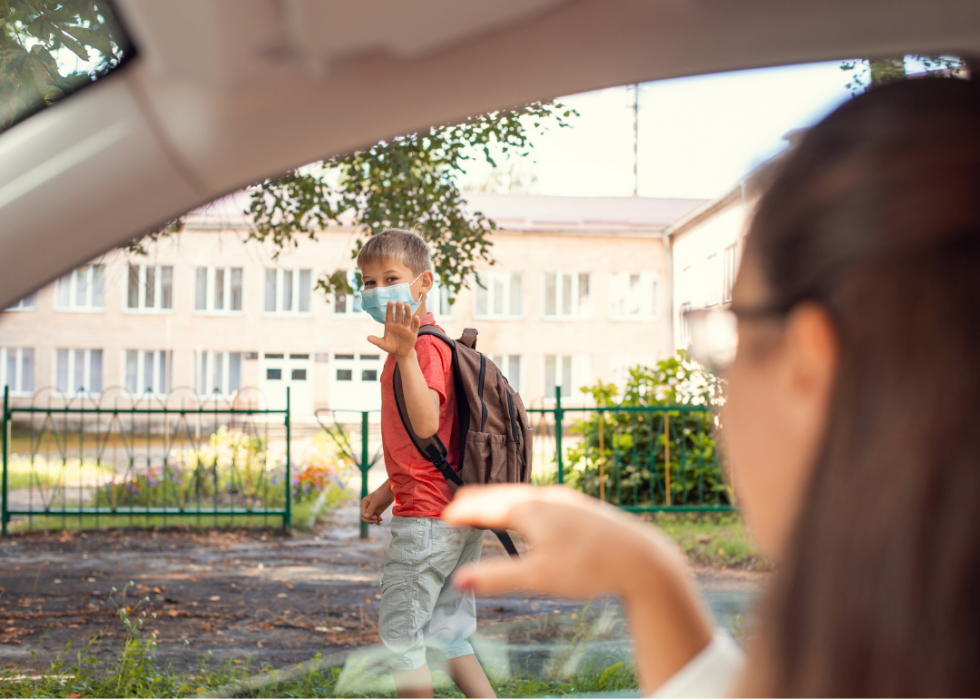
#18. Kentucky
- Overall achievement change in online math program, winter to spring 2020: -18.6%
--- Achievement change for schools in high-income ZIP codes: 18.2%
--- Achievement change for schools in low-income ZIP codes: -27.4%
--- Achievement gap: 45.6%
- Overall engagement change in online math program, winter to spring 2020: -40.4%
--- Engagement change for schools in high-income ZIP codes: -11.1%
--- Engagement change for schools in low-income ZIP codes: -47.5%
--- Engagement gap: 36.4% (#9 highest among all states)
An analysis by the Kentucky Center for Economic Policy warns that the gap in funding between rich and poor districts keeps growing. According to 2018-2019 data, the most recent available, wealthy districts had $2,840 more for each student than poor districts. Kentucky schools were to get $223 million from the CARES Act.

#17. New Mexico
- Overall achievement change in online math program, winter to spring 2020: -17.3%
--- Achievement change for schools in high-income ZIP codes: 17.8%
--- Achievement change for schools in low-income ZIP codes: -28.5%
--- Achievement gap: 46.3%
- Overall engagement change in online math program, winter to spring 2020: -32.3%
--- Engagement change for schools in high-income ZIP codes: -12.3%
--- Engagement change for schools in low-income ZIP codes: -43.6%
--- Engagement gap: 31.3% (#17 highest among all states)
New Mexico is receiving $108.6 million in federal relief funds for K-12 education. Gov. Michelle Lujan Grisham urged the federal government to provide more assistance for states like New Mexico during the coronavirus pandemic, since revenue is falling and costs are rising. But some advocates worry that students in low-income areas would not receive a fair share of the money, and three districts sued the state in July 2020 over how the state allocates funds.
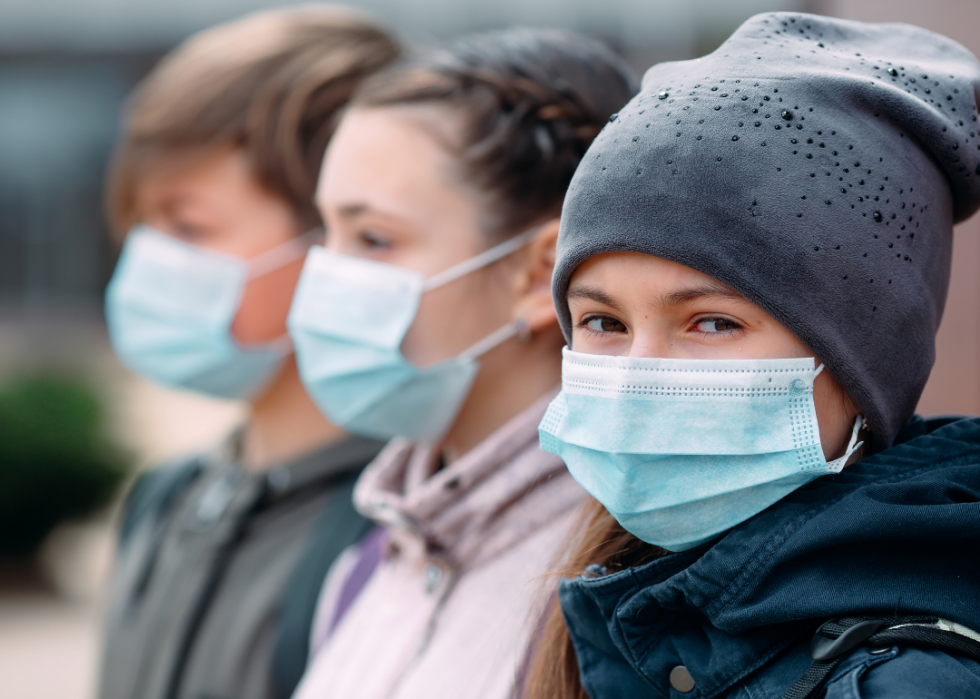
#16. Utah
- Overall achievement change in online math program, winter to spring 2020: 63.4%
--- Achievement change for schools in high-income ZIP codes: 60.6%
--- Achievement change for schools in low-income ZIP codes: 14.2%
--- Achievement gap: 46.3%
- Overall engagement change in online math program, winter to spring 2020: 18.0%
--- Engagement change for schools in high-income ZIP codes: 18.0%
--- Engagement change for schools in low-income ZIP codes: -18.1%
--- Engagement gap: 36.1% (#10 highest among all states)
Utah added $1 million to a $5 million competitive grant program to connect more K-12 students to the internet, a need made more urgent by the coronavirus pandemic. The allocation came from the state coronavirus relief funds, bringing the total to 6 million. It received $67.8 million in federal relief funds that can be used for at-risk students, educational technology, assistance for homeless students, or other purposes.

#15. Massachusetts
- Overall achievement change in online math program, winter to spring 2020: 24.9%
--- Achievement change for schools in high-income ZIP codes: 42.3%
--- Achievement change for schools in low-income ZIP codes: -4.9%
--- Achievement gap: 47.2%
- Overall engagement change in online math program, winter to spring 2020: -10.0%
--- Engagement change for schools in high-income ZIP codes: 3.2%
--- Engagement change for schools in low-income ZIP codes: -23.7%
--- Engagement gap: 26.9% (#22 highest among all states)
Massachusetts allocated more than $50 million from the federal CARES Act to education at the elementary, secondary, and university levels. The money, from the Governor’s Emergency Education Relief Fund, was allocated toward improving early literacy and expanding remote learning, among other uses.

#14. Oregon
- Overall achievement change in online math program, winter to spring 2020: 13.4%
--- Achievement change for schools in high-income ZIP codes: 65.4%
--- Achievement change for schools in low-income ZIP codes: 14.4%
--- Achievement gap: 50.9%
- Overall engagement change in online math program, winter to spring 2020: -21.9%
--- Engagement change for schools in high-income ZIP codes: 1.9%
--- Engagement change for schools in low-income ZIP codes: -25.6%
--- Engagement gap: 27.5% (#21 highest among all states)
Oregon received about $114 million for its public schools, $8.4 million of which went to the Portland Public School District. It was being put toward building its distance learning programs as well as supporting a full roster of teachers to create online learning plans for when the students returned to school.

#13. Nevada
- Overall achievement change in online math program, winter to spring 2020: 6.9%
--- Achievement change for schools in high-income ZIP codes: 17.9%
--- Achievement change for schools in low-income ZIP codes: -33.3%
--- Achievement gap: 51.2%
- Overall engagement change in online math program, winter to spring 2020: -19.6%
--- Engagement change for schools in high-income ZIP codes: -7.9%
--- Engagement change for schools in low-income ZIP codes: -39.7%
--- Engagement gap: 31.7% (#16 highest among all states)
Nevada got $117 million in the Elementary and Secondary School Emergency Fund of the CARES Act, plus another $26 million from a separate fund. It launched "Connecting Kids,” an initiative to be carried out by community groups and others, which focuses on ensuring students have access to the internet and to computer devices.

#12. New Jersey
- Overall achievement change in online math program, winter to spring 2020: 18.8%
--- Achievement change for schools in high-income ZIP codes: 53.3%
--- Achievement change for schools in low-income ZIP codes: 1.2%
--- Achievement gap: 52.0%
- Overall engagement change in online math program, winter to spring 2020: -8.5%
--- Engagement change for schools in high-income ZIP codes: 15.8%
--- Engagement change for schools in low-income ZIP codes: -23.6%
--- Engagement gap: 39.4% (#8 highest among all states)
New Jersey estimates it has 230,000 students held back by a "digital divide," lacking access to laptops, computers, and other devices. The governor has allocated $54 million to help close it, obtained from the Elementary and Secondary School Emergency Fund of the CARES Act and the state's Coronavirus Relief Fund.
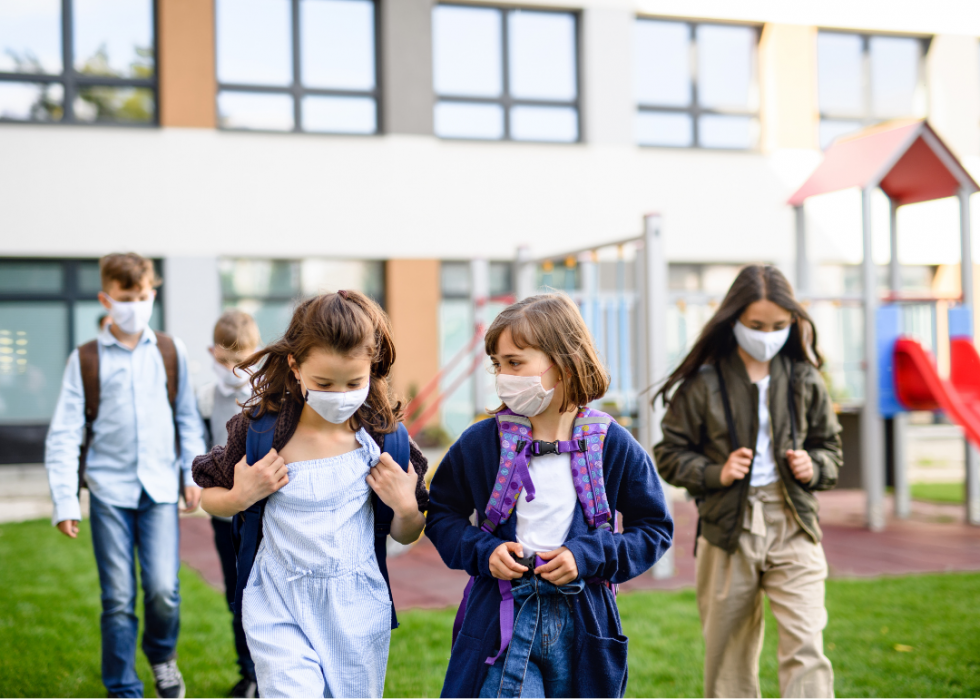
#11. Washington D.C.
- Overall achievement change in online math program, winter to spring 2020: 29.9%
--- Achievement change for schools in high-income ZIP codes: 64.3%
--- Achievement change for schools in low-income ZIP codes: 11.6%
--- Achievement gap: 52.7%
- Overall engagement change in online math program, winter to spring 2020: -4.4%
--- Engagement change for schools in high-income ZIP codes: 16.3%
--- Engagement change for schools in low-income ZIP codes: -17.2%
--- Engagement gap: 33.5% (#15 highest among all states)
Despite pandemic-related drops in revenue, Washington D.C., approved a budget that funds a 3% increase in per-student dollars and $900,000 for early literacy intervention to keep kids reading at grade level by third grade.
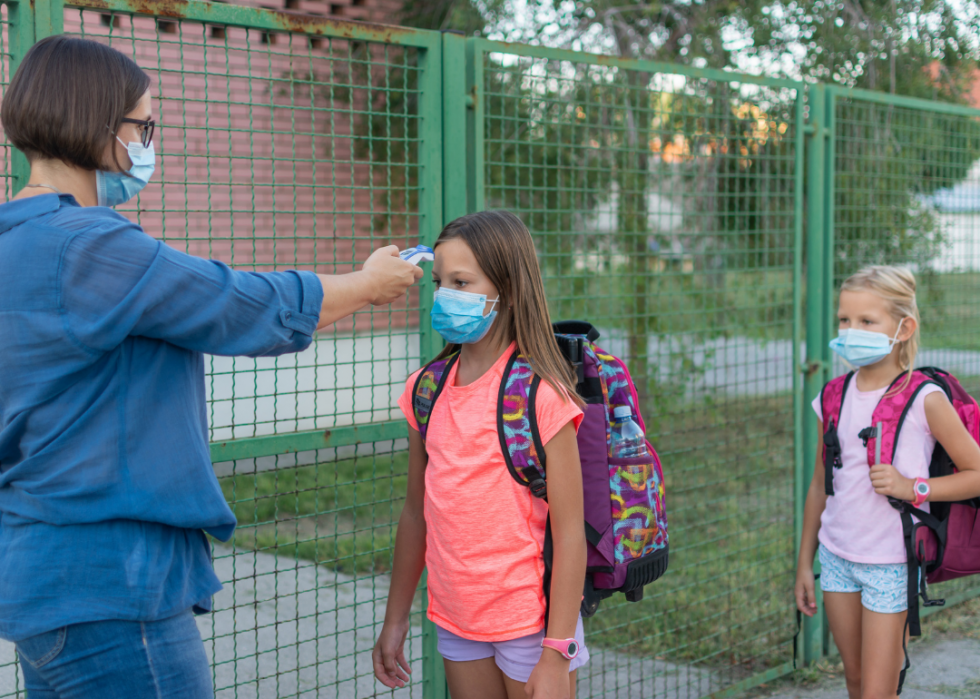
#10. Alabama
- Overall achievement change in online math program, winter to spring 2020: -37.4%
--- Achievement change for schools in high-income ZIP codes: 11.5%
--- Achievement change for schools in low-income ZIP codes: -44.3%
--- Achievement gap: 55.7%
- Overall engagement change in online math program, winter to spring 2020: -48.6%
--- Engagement change for schools in high-income ZIP codes: -20.5%
--- Engagement change for schools in low-income ZIP codes: -54.0%
--- Engagement gap: 33.5% (#14 highest among all states)
Alabama will spend up to $300 million for remote learning from its COVID-19 federal relief funds, $100 million of which will go directly to schools to buy electronic devices and software. Another $70 million is set aside for health and wellness in the schools during the coronavirus pandemic.

#9. Missouri
- Overall achievement change in online math program, winter to spring 2020: -5.8%
--- Achievement change for schools in high-income ZIP codes: 33.4%
--- Achievement change for schools in low-income ZIP codes: -27.0%
--- Achievement gap: 60.4%
- Overall engagement change in online math program, winter to spring 2020: -27.0%
--- Engagement change for schools in high-income ZIP codes: -2.8%
--- Engagement change for schools in low-income ZIP codes: -38.3%
--- Engagement gap: 35.5% (#13 highest among all states)
Missouri will use $55 million from the state’s Coronavirus Relief Fund to tackle access to the internet for students and learning loss while schools were closed. One in every five students did not have Wi-Fi, or could not afford it, and so could not complete lessons. The state will spend $10 million to reimburse school districts for what they spent to help students get online, as well as $20 million for additional devices.
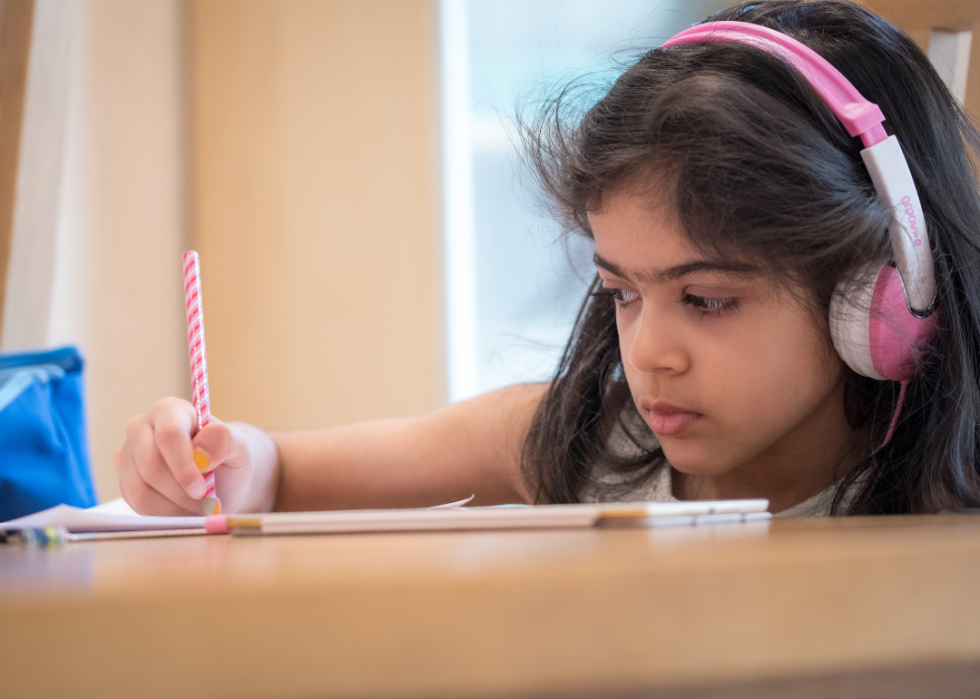
#8. Wisconsin
- Overall achievement change in online math program, winter to spring 2020: -11.5%
--- Achievement change for schools in high-income ZIP codes: 30.2%
--- Achievement change for schools in low-income ZIP codes: -33.5%
--- Achievement gap: 63.7%
- Overall engagement change in online math program, winter to spring 2020: -18.9%
--- Engagement change for schools in high-income ZIP codes: 14.7%
--- Engagement change for schools in low-income ZIP codes: -29.3%
--- Engagement gap: 44.0% (#5 highest among all states)
Wisconsin’s governor made grants available based on students’ economic disadvantages, a lack of access to computing devices and the internet, and English proficiency. The money comes from the $46.6 million Governor’s Emergency Education Relief Fund, established under the CARES Act.
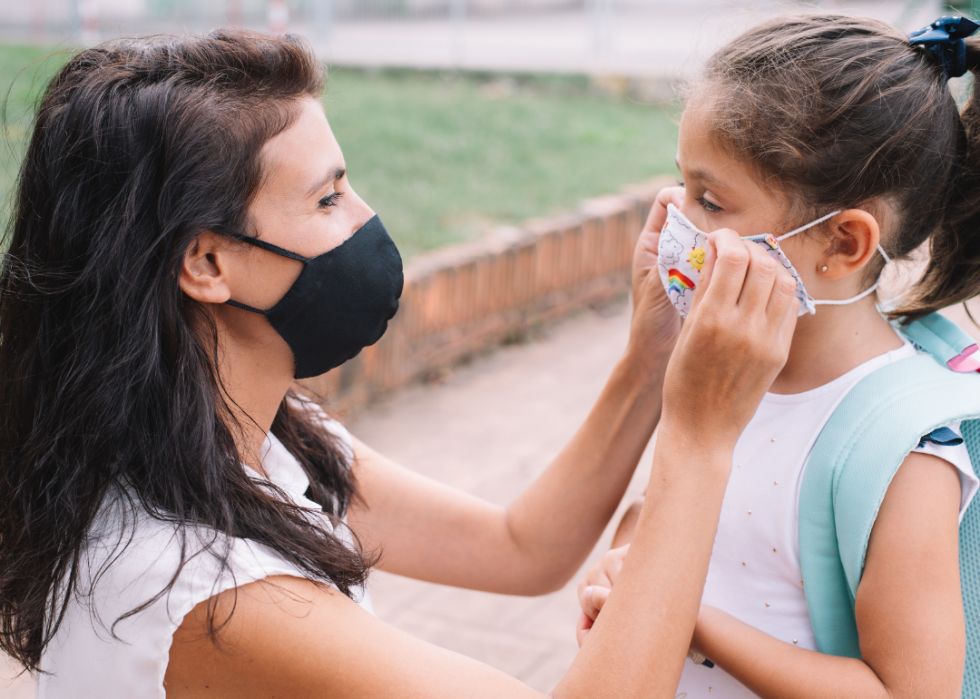
#7. Arizona
- Overall achievement change in online math program, winter to spring 2020: -10.9%
--- Achievement change for schools in high-income ZIP codes: 31.4%
--- Achievement change for schools in low-income ZIP codes: -32.6%
--- Achievement gap: 64.0%
- Overall engagement change in online math program, winter to spring 2020: -31.9%
--- Engagement change for schools in high-income ZIP codes: -4.9%
--- Engagement change for schools in low-income ZIP codes: -46.2%
--- Engagement gap: 41.3% (#6 highest among all states)
Arizona schools are receiving $270 million in federal funds to help them reopen after the pandemic closures. Most of $40 million allocated for dealing with the "digital divide" will go to improving internet access in rural areas. There is no federal money to buy computers or other equipment for students.
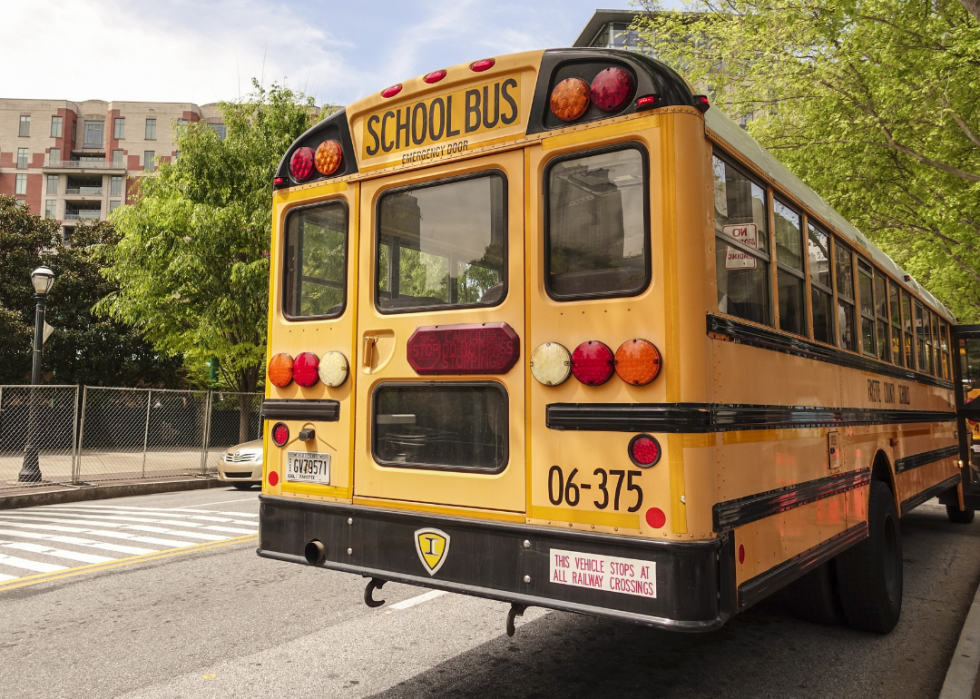
#6. Georgia
- Overall achievement change in online math program, winter to spring 2020: 0.0%
--- Achievement change for schools in high-income ZIP codes: 35.4%
--- Achievement change for schools in low-income ZIP codes: -31.3%
--- Achievement gap: 66.7%
- Overall engagement change in online math program, winter to spring 2020: -27.9%
--- Engagement change for schools in high-income ZIP codes: -8.0%
--- Engagement change for schools in low-income ZIP codes: -44.0%
--- Engagement gap: 36.0% (#11 highest among all states)
Georgia’s schools got more than $450 million in federal COVID-19 funds from the CARES Act, based on the number of poor students in a district. Schools are using the funds to buy computers, train teachers, and otherwise respond to the coronavirus crisis. However, the state education budget was also cut by $1.6 billion.
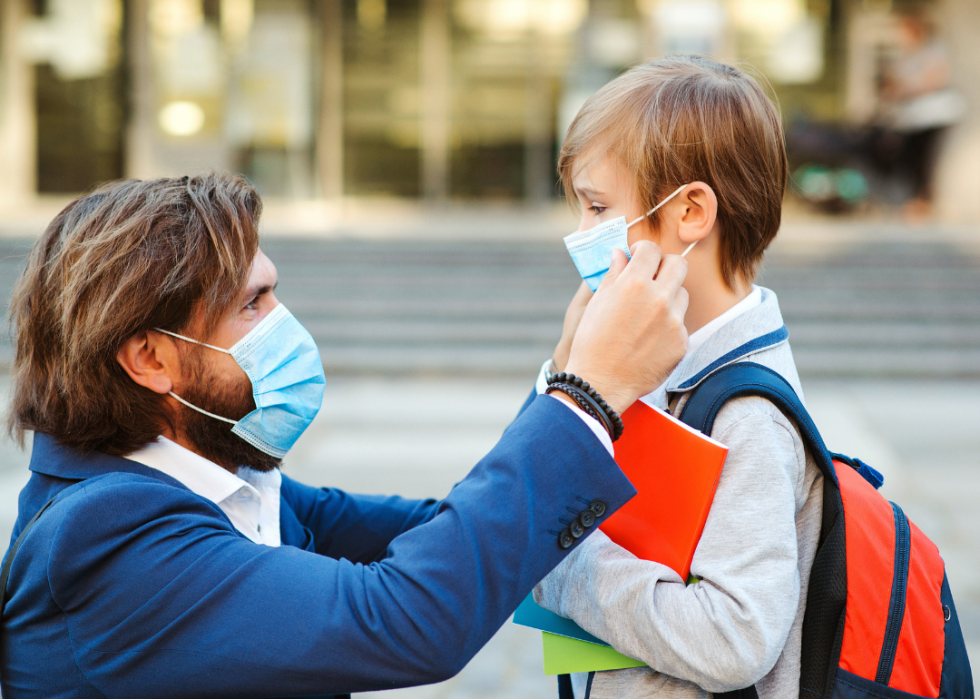
#5. New Hampshire
- Overall achievement change in online math program, winter to spring 2020: 81.3%
--- Achievement change for schools in high-income ZIP codes: 114.7%
--- Achievement change for schools in low-income ZIP codes: 42.9%
--- Achievement gap: 71.8%
- Overall engagement change in online math program, winter to spring 2020: 15.6%
--- Engagement change for schools in high-income ZIP codes: 46.0%
--- Engagement change for schools in low-income ZIP codes: 5.5%
--- Engagement gap: 40.5% (#7 highest among all states)
New Hampshire had allocated $33.9 million to its schools from the CARES Act earlier in 2020, and in October announced receipt of an additional $45 million to deal with the cost of the pandemic. Gov. Chris Sununu said the money could be spent on things like Chromebooks, computers, or technology while students were studying through a hybrid learning model or a remote one.
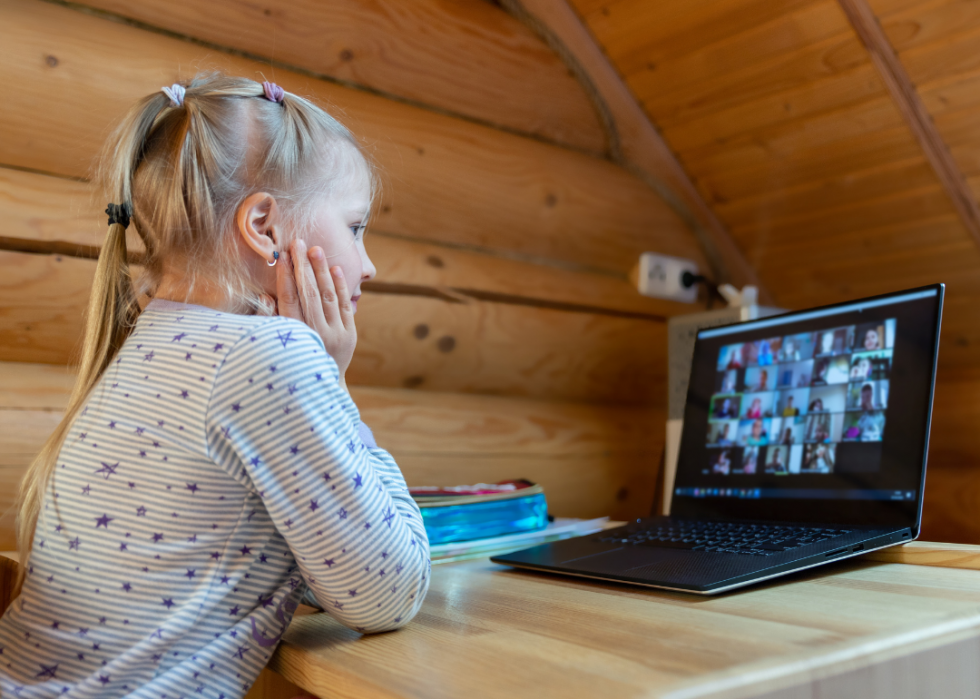
#4. Alaska
- Overall achievement change in online math program, winter to spring 2020: -48.4%
--- Achievement change for schools in high-income ZIP codes: 5.6%
--- Achievement change for schools in low-income ZIP codes: -69.7%
--- Achievement gap: 75.3%
- Overall engagement change in online math program, winter to spring 2020: -62.8%
--- Engagement change for schools in high-income ZIP codes: -51.3%
--- Engagement change for schools in low-income ZIP codes: -67.5%
--- Engagement gap: 16.1% (#28 highest among all states)
Alaska received just over $38 million in coronavirus relief funds for its schools, but Gov. Mike Dunleavy vetoed $30 million in education money in the state budget. He said the federal funds would make up for it, but school officials point out that there are restrictions on how those funds are spent. The upshot? School districts are scrambling for funds.
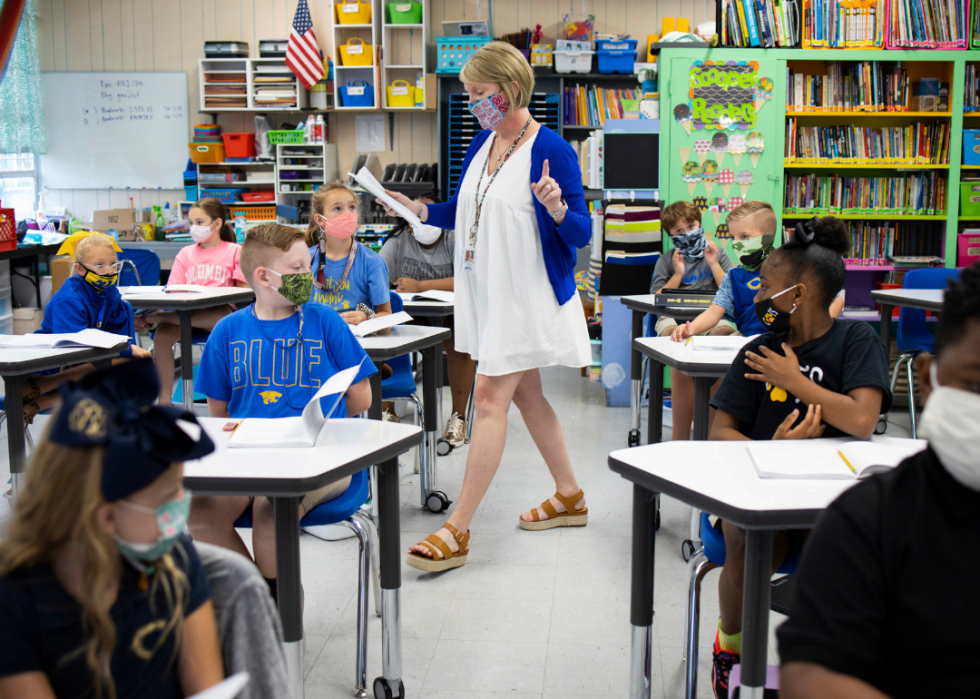
#3. Mississippi
- Overall achievement change in online math program, winter to spring 2020: -55.4%
--- Achievement change for schools in high-income ZIP codes: 4.2%
--- Achievement change for schools in low-income ZIP codes: -76.5%
--- Achievement gap: 80.7%
- Overall engagement change in online math program, winter to spring 2020: -59.6%
--- Engagement change for schools in high-income ZIP codes: -26.4%
--- Engagement change for schools in low-income ZIP codes: -71.6%
--- Engagement gap: 45.2% (#3 highest among all states)
Mississippi received $34.6 million for its schools through the Governor’s Emergency Education Relief Fund of the CARES Act, and in September 2020 was still allocating the money, long after most other states awarded funds. Gov. Tate Reeves was waiting to see how the legislature would divvy up other relief money for distance learning.
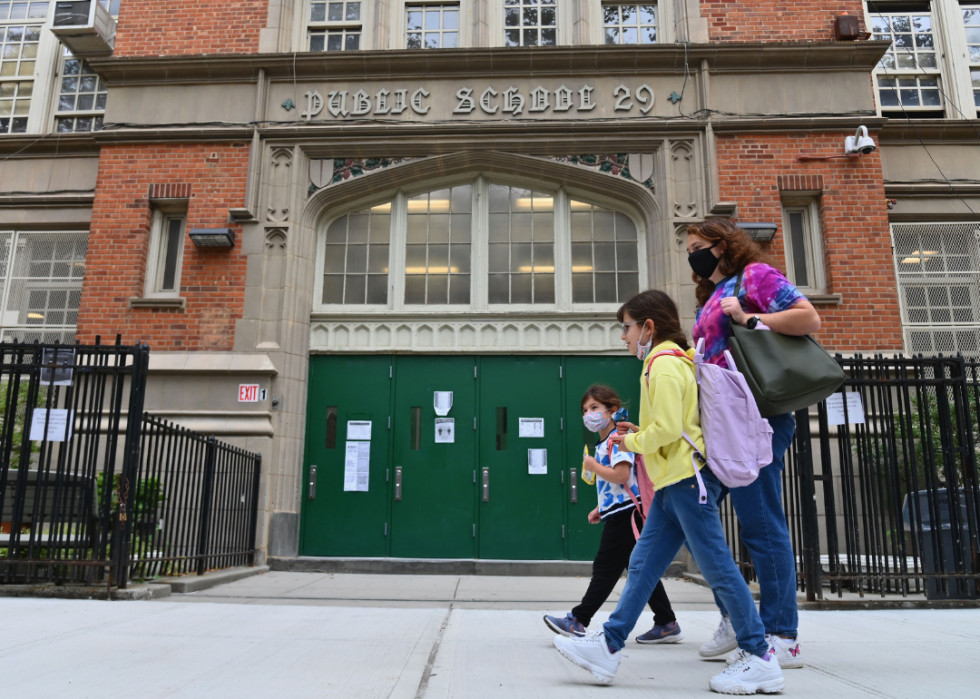
#2. New York
- Overall achievement change in online math program, winter to spring 2020: 24.1%
--- Achievement change for schools in high-income ZIP codes: 68.6%
--- Achievement change for schools in low-income ZIP codes: -14.4%
--- Achievement gap: 83.0%
- Overall engagement change in online math program, winter to spring 2020: -5.9%
--- Engagement change for schools in high-income ZIP codes: 19.7%
--- Engagement change for schools in low-income ZIP codes: -29.2%
--- Engagement gap: 48.8% (#2 highest among all states)
New York City, the country's largest school district, is buying 100,000 iPads to add to the 350,000 it already has, as well as keyboards for students to use the iPads more easily. However, it lacks the 77,000 tablets and laptops it still needs. Its universal pre-K program will not expand as quickly because of budget cuts.
.
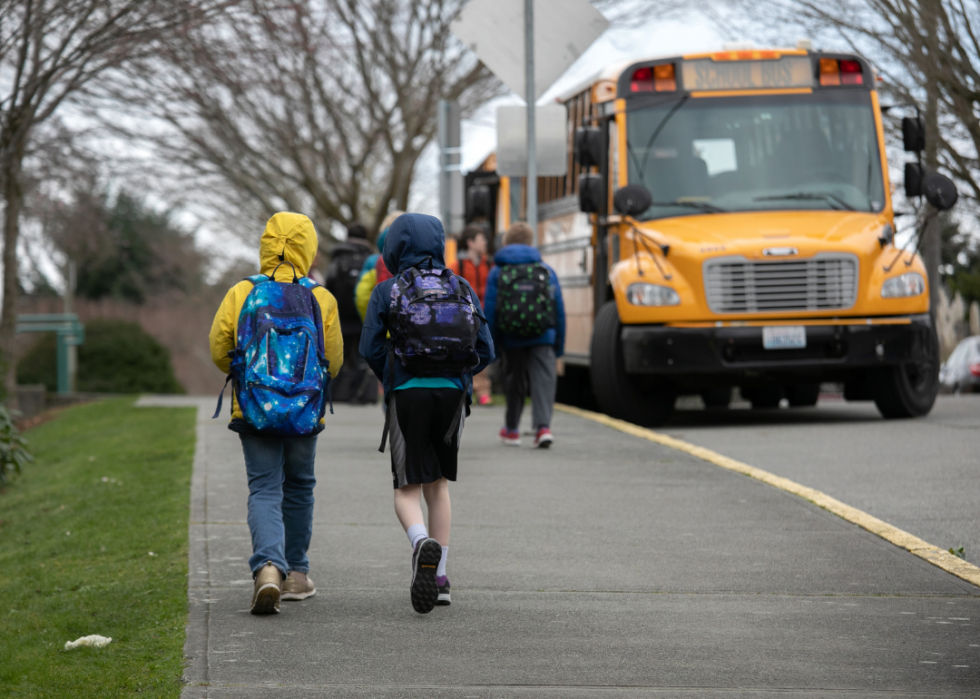
#1. Washington
- Overall achievement change in online math program, winter to spring 2020: 26.3%
--- Achievement change for schools in high-income ZIP codes: 77.9%
--- Achievement change for schools in low-income ZIP codes: -23.8%
--- Achievement gap: 101.8%
- Overall engagement change in online math program, winter to spring 2020: -12.3%
--- Engagement change for schools in high-income ZIP codes: 18.5%
--- Engagement change for schools in low-income ZIP codes: -33.2%
--- Engagement gap: 51.7% (#1 highest among all states)
Washington received about $217 million for its schools through the Elementary and Secondary School Emergency Relief Fund of the CARES Act. The state’s constitution protects K-12 spending, but advocates are wondering how the high costs of distance learning and other pressures on the schools will affect schools.



